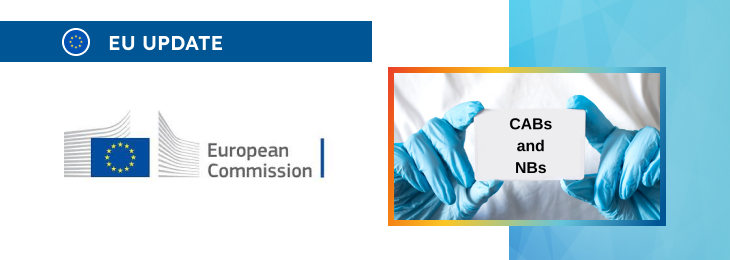The new article describes in detail the approach to be applied when it comes to the re-assessment of designation under the new regulatory framework.

Table of content
The Medical Device Coordination Group (MDCG), the European agency focused on further improvement of the medical device regulatory framework, has published a guidance document dedicated to the designation, re-assessment, and notification of conformity assessment bodies and notified bodies. The document provides an overview of the applicable regulatory requirements, as well as additional clarifications and recommendations to be taken into consideration by medical device manufacturers and other parties involved in order to ensure compliance.
At the same time, provisions of the guidance are non-binding in their legal nature, nor are they intended to introduce new rules or impose new obligations. Furthermore, they could be subject to changes, should such changes be reasonably necessary to reflect corresponding amendments to the underlying regulations.
Re-assessments of Notified Bodies: Basics
The scope of the guidance covers, inter alia, the reassessment process for Notified Bodies (NBs). According to the document, it generally follows the same procedure as the initial designation assessments of Conformity Assessment Bodies (CABs).
However, specific differences exist to align with the re-assessment goals and regulatory requirements aimed at ensuring medical device safety. Twice annually, in January and July, the Commission (COM) sends letters to designating authorities informing them of NBs eligible for re-assessment within the next 12 months.
Designating authorities request NBs to provide relevant documentation to verify compliance with the MDR (Article 44(10)) and IVDR (Article 40(10)).
This documentation includes:
- Specification of conformity assessment activities and types of devices, using codes from Implementing Regulation (EU) 2017/2185.
- List of certificates held by the NB.
- Copy of the matrix detailing personnel authorizations and responsibilities.
- Quality management system documentation, including structure, document lists, and process interrelations.
NBs should submit this documentation 3-6 months before their eligibility for re-assessment, ideally 5 years from their initial notification and every fifth year thereafter. The designating authority conducts an initial check for completeness within 30 days of receiving the documentation.
If information is missing, it must be requested within these 30 days, with deadlines set for submission. If the NB fails to provide complete information after multiple requests, the reassessment process may be terminated, initiating activities under Article 46(4) of the MDR or Article 42(4) of the IVDR.
The transmission of re-assessment documentation to the Commission follows established procedures. Designating authorities review the documentation against the requirements of Annex VII to the MDR/IVDR and related regulations. Monitoring and assessment results may also be considered.
This review is documented in the Preliminary Re-assessment Report (PRAR), preferably in English, triggering the appointment of a Joint Assessment Team (JAT) and scheduling of the on-site assessment. The authority ensures the review outcome is comprehensive, requesting further information from the NB as needed.

On-site Assessment Activities
The on-site assessment follows the same procedure as described for the initial assessment, led by the designating authority team with active JAT participation.
The assessment includes:
- Reviewing the NB’s quality management system documentation.
- Assessing NB conformity assessment activities, including technical and clinical documentation reviews per Article 45(4) of the MDR and Article 41(4) of the IVDR.
- Evaluating relevant changes since the last designation/re-assessment.
The on-site assessment adheres to the agreed plan, aiming to avoid lengthy sessions at the NB’s premises, with evening coordination meetings planned elsewhere. The procedure includes focusing on technical and clinical documentation reviews and classifying non-compliances based on their impact on conformity assessments and device safety.
The post on-site assessment activities follow a similar procedure ensuring thorough follow-up on identified non-compliances and corrective actions.
Re-assessment Conclusion
As explained in the document, the designating authority verifies the implementation and effectiveness of Corrective Action and Preventive Action (CAPA) plans before deciding on the NB’s compliance status. Non-compliances are classified as closed or to be followed-up based on verification outcomes.
The designating authority’s final re-assessment report includes:
- Conclusion on whether the NB meets MDR/IVDR requirements.
- Recommendation on any amendments to the NB’s scope of designation, including conditions if the recommended scope differs from the existing designation.
The report, Key Information Document, and draft amended designation (if applicable) are submitted to DG SANTE within 2 months of CAPA plan implementation. DG SANTE then transmits these documents to the MDCG and JAT, acknowledging receipt via email.
The JAT reviews the final re-assessment report, providing an opinion on the NB’s compliance and any recommended scope amendments. The MDCG issues a recommendation within 42 days, influencing the designating authority’s final decision.
The designating authority considers the MDCG’s recommendation in making the final decision on the NB’s compliance with designation requirements.
Update of Notification in NANDO
The document also covers the matters related to the update of notification in NANDO.
According to the document, upon completing the reassessment procedure, the designating authority updates the notification in NANDO, including:
- Supporting documents from the reassessment process.
- JAT final opinion.
- MDCG recommendation.
- Final decision by the designating authority.
The designating authority enters the date for the next re-assessment, recommended to be five years (+1 month) after the notification update, ensuring continued regulatory compliance and safety of medical devices.
Conclusion
In summary, the present guidance issued by the MDCG provides detailed explanations and clarifications regarding the processes and procedures associated with the designation of Notified Bodies and Conformity Assessment Bodies as set forth under the applicable regulatory requirements. The document outlines the key steps to be taken by all the parties involved, emphasizing the most important aspects.
How Can RegDesk Help?
RegDesk is an AI-powered Regulatory Information Management System that provides medical device companies with regulatory intelligence for over 120 markets worldwide. It can help you prepare and publish global applications, manage standards, run change assessments, and obtain real-time alerts on regulatory changes through a centralized platform. Global expansion has never been this simple.

